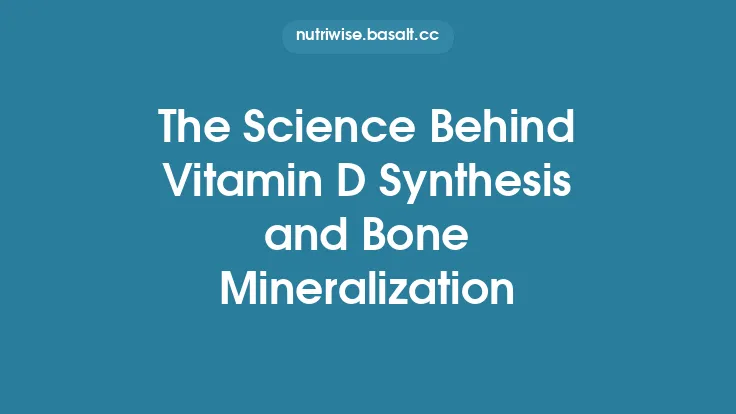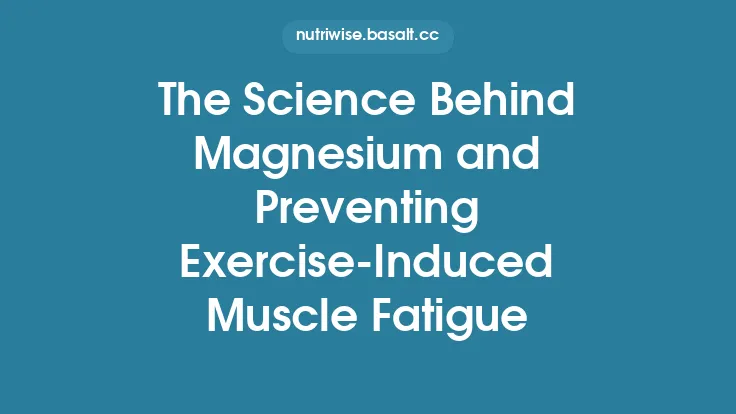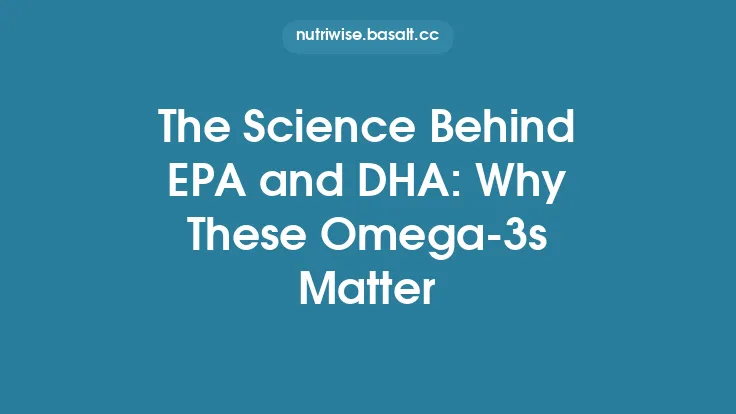The human body relies on a finely tuned series of processes to extract the trace amounts of essential minerals that are present in the foods we eat. Unlike macronutrients, which are consumed in gram quantities, minerals are needed in milligram‑to‑microgram ranges, making the efficiency of their absorption a critical determinant of nutritional status. This article delves into the science of mineral absorption, exploring the anatomical routes, molecular mechanisms, dietary influences, and individual factors that together shape how much of each mineral actually reaches the bloodstream and, ultimately, the cells that need it.
Physiological Pathways of Mineral Uptake
- Oral Ingestion → Gastric Phase
- pH‑dependent solubilization: Many minerals (e.g., iron, calcium) become more soluble in the acidic environment of the stomach, forming ionic species that are ready for transport.
- Complex formation: Some minerals bind to dietary ligands (e.g., phytates, oxalates) forming insoluble complexes that resist further absorption.
- Duodenal and Jejunal Absorption
- Primary site: The proximal small intestine provides the greatest surface area and the highest expression of specific transport proteins.
- Enterocyte uptake: Minerals cross the apical membrane of enterocytes via either passive diffusion (for highly soluble ions) or active, carrier‑mediated transport.
- Ileal and Colonic Contributions
- Secondary absorption: Certain minerals, especially those that are poorly absorbed earlier (e.g., magnesium), can be reclaimed in the distal intestine and colon, often facilitated by microbial metabolism that liberates bound forms.
- Portal Circulation and Systemic Distribution
- After crossing the basolateral membrane, minerals enter the portal vein, where they may bind to carrier proteins (e.g., transferrin for iron) before distribution to target tissues.
Molecular Transporters and Channels
| Mineral | Primary Transporter(s) | Mechanism | Regulation |
|---|---|---|---|
| Iron (Fe²⁺) | Divalent Metal Transporter‑1 (DMT1) | Proton‑coupled symport | Up‑regulated by hypoxia‑inducible factor (HIF) under iron deficiency |
| Calcium (Ca²⁺) | Transient Receptor Potential Vanilloid 6 (TRPV6) & Calcium‑ATPase (PMCA1b) | Facilitated diffusion + active extrusion | Vitamin D‑dependent transcriptional control |
| Zinc (Zn²⁺) | ZIP4 (SLC39A4) for influx; ZnT1 (SLC30A1) for efflux | ZIP family increases cytosolic Zn²⁺; ZnT family pumps out excess | Modulated by intracellular zinc levels and metallothionein expression |
| Magnesium (Mg²⁺) | TRPM6/7 channels, SLC41A1 transporter | Electrogenic channel + Na⁺/Mg²⁺ exchange | Hormonal regulation via parathyroid hormone (PTH) and estrogen |
| Copper (Cu⁺) | Copper Transporter 1 (CTR1) | High‑affinity uptake of Cu⁺ | Controlled by copper‑responsive transcription factor (MTF‑1) |
| Selenium (Se⁴⁻/Se⁶⁺) | Sodium‑dependent selenite transporter (SLC5A8) | Co‑transport with Na⁺ | Influenced by dietary selenium status |
These transporters are often expressed in a tissue‑specific manner, and many are subject to post‑translational modifications (phosphorylation, ubiquitination) that fine‑tune their activity in response to acute changes in mineral availability.
Influence of Gastrointestinal Environment
- pH Gradient: The stomach’s low pH (≈1–3) promotes dissolution of many mineral salts, while the duodenum’s higher pH (≈6–7) can precipitate certain ions unless they are complexed with ligands that maintain solubility.
- Mucosal Surface Area: Villi and microvilli increase absorptive surface area up to 200 m² in a healthy adult, directly impacting the capacity for mineral uptake.
- Intestinal Motility: Rapid transit reduces contact time between minerals and absorptive epithelium, potentially lowering absorption efficiency, especially for minerals that rely on carrier‑mediated uptake.
- Microbiota Interactions: Gut bacteria can liberate bound minerals (e.g., phytate hydrolysis releasing zinc) or sequester them (e.g., siderophore production affecting iron availability). Dysbiosis may therefore shift the balance of mineral bioavailability.
Role of Dietary Components and Antagonists
| Enhancers | Mechanism |
|---|---|
| Vitamin C (ascorbic acid) | Reduces Fe³⁺ to Fe²⁺, increasing DMT1 affinity |
| Lactose | Forms soluble calcium‑lactate complexes, improving calcium absorption |
| Organic acids (citric, malic) | Chelate minerals, maintaining them in soluble forms |
| Prebiotic fibers (inulin, fructooligosaccharides) | Promote beneficial microbiota that release bound minerals |
| Inhibitors | Mechanism |
|---|---|
| Phytates (phytic acid) | Strongly chelate Fe²⁺, Zn²⁺, Ca²⁺, forming insoluble complexes |
| Oxalates | Form calcium oxalate crystals, reducing calcium bioavailability |
| Polyphenols (tannins) | Bind iron and zinc, decreasing their solubility |
| Excess dietary calcium | Competes with magnesium and iron for shared transport pathways |
The net effect of a mixed diet is the result of these competing interactions. For instance, a meal rich in whole grains (high phytate) and meat (high heme iron) may still achieve adequate iron absorption because heme iron utilizes a distinct, phytate‑insensitive pathway.
Impact of Food Processing and Preparation
- Fermentation: Lactic‑acid fermentation degrades phytates, markedly improving zinc and iron bioavailability in cereals and legumes.
- Soaking & Sprouting: Soaking grains in alkaline water and allowing them to sprout activates endogenous phytases, reducing phytate content by up to 70 %.
- Thermal Processing: Boiling can leach water‑soluble minerals, while roasting may concentrate minerals but also create insoluble complexes with Maillard reaction products.
- Fortification Techniques: Micronization (reducing particle size) and encapsulation (e.g., liposomal iron) enhance dissolution rates and protect minerals from antagonists during digestion.
Understanding these processing effects enables nutrition professionals to recommend preparation methods that maximize mineral absorption without compromising food safety or palatability.
Genetic and Epigenetic Modulators of Absorption
- Polymorphisms in Transporter Genes: Variants in *SLC30A8 (ZnT8) affect zinc handling in pancreatic β‑cells, influencing systemic zinc status. Similarly, DMT1* (SLC11A2) polymorphisms can alter iron uptake efficiency.
- Regulatory Gene Variants: Mutations in *HFE (hemochromatosis) disrupt iron sensing, leading to excessive absorption. TRPV6* variants have been linked to altered calcium absorption and bone density.
- Epigenetic Influences: DNA methylation of promoter regions for transporters (e.g., *ZIP4*) can be modulated by early‑life nutrition, potentially programming lifelong mineral absorption capacity.
- MicroRNA Regulation: Specific miRNAs (e.g., miR‑122) have been shown to down‑regulate *CTR1* expression, affecting copper uptake under certain physiological conditions.
These genetic factors explain inter‑individual variability in mineral status even when dietary intake appears adequate.
Age, Health Status, and Physiological States
| Life Stage / Condition | Typical Absorption Changes | Clinical Implications |
|---|---|---|
| Infancy | High efficiency for calcium and iron due to rapid growth; reliance on breast milk factors (lactoferrin) | Importance of iron‑fortified formulas for preterm infants |
| Adolescence | Increased calcium and zinc absorption driven by growth hormone and sex steroids | Need for adequate dietary calcium to support peak bone mass |
| Pregnancy | Up‑regulated intestinal iron and calcium transport via hormonal signals (estrogen, placental factors) | Risk of iron deficiency anemia if intake does not meet heightened demand |
| Elderly | Reduced gastric acid secretion (hypochlorhydria) impairs solubilization of iron and calcium; decreased expression of transporters | Consideration of chelated mineral supplements or acid‑enhancing strategies |
| Chronic Kidney Disease | Altered phosphate handling and secondary hyperparathyroidism affect calcium and magnesium balance | Monitoring of mineral supplementation to avoid vascular calcification |
| Inflammatory Bowel Disease | Mucosal damage diminishes absorptive surface; altered microbiota impacts mineral release | Targeted supplementation and possibly parenteral routes for severe deficiencies |
Understanding these context‑specific shifts helps clinicians tailor interventions that respect the underlying physiology rather than applying a one‑size‑fits‑all approach.
Assessing Mineral Absorption in Research and Clinical Settings
- Stable Isotope Tracer Studies
- Method: Administer a non‑radioactive isotope (e.g., ^57Fe, ^70Zn) and measure its appearance in blood or urine over time.
- Strengths: Direct quantification of fractional absorption; minimal invasiveness.
- Limitations: Requires specialized mass spectrometry equipment and careful dietary control.
- Dual‑Isotope Ratio Method
- Simultaneous ingestion of a test isotope and a reference isotope (often administered intravenously) allows calculation of absolute absorption rates, correcting for individual metabolic differences.
- Enterocyte Brush‑Border Enzyme Activity
- Measuring expression levels of transporters (via biopsy or non‑invasive fecal mRNA) provides indirect insight into absorptive capacity.
- Serum Biomarkers
- Ferritin, transferrin saturation for iron; serum calcium (adjusted for albumin) for calcium; magnesium RBC levels for magnesium status.
- While useful for overall status, they do not isolate absorption efficiency and can be confounded by inflammation or renal function.
- In Vitro Models
- Caco‑2 cell monolayers simulate human intestinal epithelium, allowing mechanistic studies of transporter regulation under controlled conditions.
Combining multiple assessment tools yields the most robust picture of mineral absorption dynamics.
Strategies to Optimize Absorption Without Overstepping Homeostasis
- Meal Timing: Pairing iron‑rich foods with vitamin C‑containing beverages, while spacing them away from calcium‑rich dairy, minimizes competitive inhibition.
- Food Pairing: Incorporate fermented foods (e.g., kimchi, tempeh) to reduce phytate load and enhance zinc and iron availability.
- Supplement Formulation: Use chelated minerals (e.g., iron bisglycinate, magnesium citrate) that bypass some transporter limitations and reduce gastrointestinal irritation.
- Acid‑Enhancing Approaches: For older adults with hypochlorhydria, low‑dose betaine HCl or apple cider vinegar before meals can improve solubilization of certain minerals.
- Targeted Probiotic Use: Strains such as *Lactobacillus plantarum* produce phytase, aiding in phytate degradation and improving mineral release.
- Monitoring and Adjustment: Periodic assessment of serum biomarkers and, when indicated, fractional absorption tests guide individualized dosing, preventing excess accumulation that could lead to toxicity (e.g., iron overload, hypercalcemia).
These evidence‑based tactics respect the body’s tightly regulated mineral homeostasis while enhancing the proportion of dietary minerals that become bioavailable.
Future Directions and Emerging Technologies
- Nanoparticle Delivery Systems: Research into mineral‑loaded liposomes and polymeric nanoparticles aims to protect ions through the gastric phase and release them at specific intestinal sites, potentially increasing bioavailability by 30–50 % in pilot studies.
- CRISPR‑Based Modulation of Transporters: Early animal models have demonstrated that up‑regulating *DMT1* expression in enterocytes can correct iron‑deficiency anemia without systemic iron overload, opening avenues for gene‑therapy‑adjacent interventions.
- Artificial Intelligence for Diet Optimization: Machine‑learning algorithms that integrate individual genetic data, gut microbiome profiles, and dietary patterns can predict personalized mineral absorption efficiency, guiding precision nutrition recommendations.
- Wearable Sensors for Real‑Time Monitoring: Emerging biosensor patches capable of detecting trace mineral concentrations in interstitial fluid could provide immediate feedback on absorption after meals, facilitating dynamic dietary adjustments.
- Microbiome Engineering: Synthetic biology approaches to engineer gut microbes that express high‑activity phytases or siderophore‑binding proteins may become a probiotic strategy to boost mineral bioavailability in populations reliant on plant‑based diets.
Continued interdisciplinary collaboration among nutrition scientists, gastroenterologists, molecular biologists, and data scientists will be essential to translate these innovations from bench to bedside.
In summary, the absorption of essential minerals is a complex, multi‑layered process governed by gastrointestinal physiology, molecular transport mechanisms, dietary composition, genetic makeup, and life‑stage specific demands. By dissecting each component and applying evidence‑based strategies, health professionals can more accurately assess mineral status, tailor interventions, and ultimately support the body’s intricate balance of micronutrients for long‑term health.





